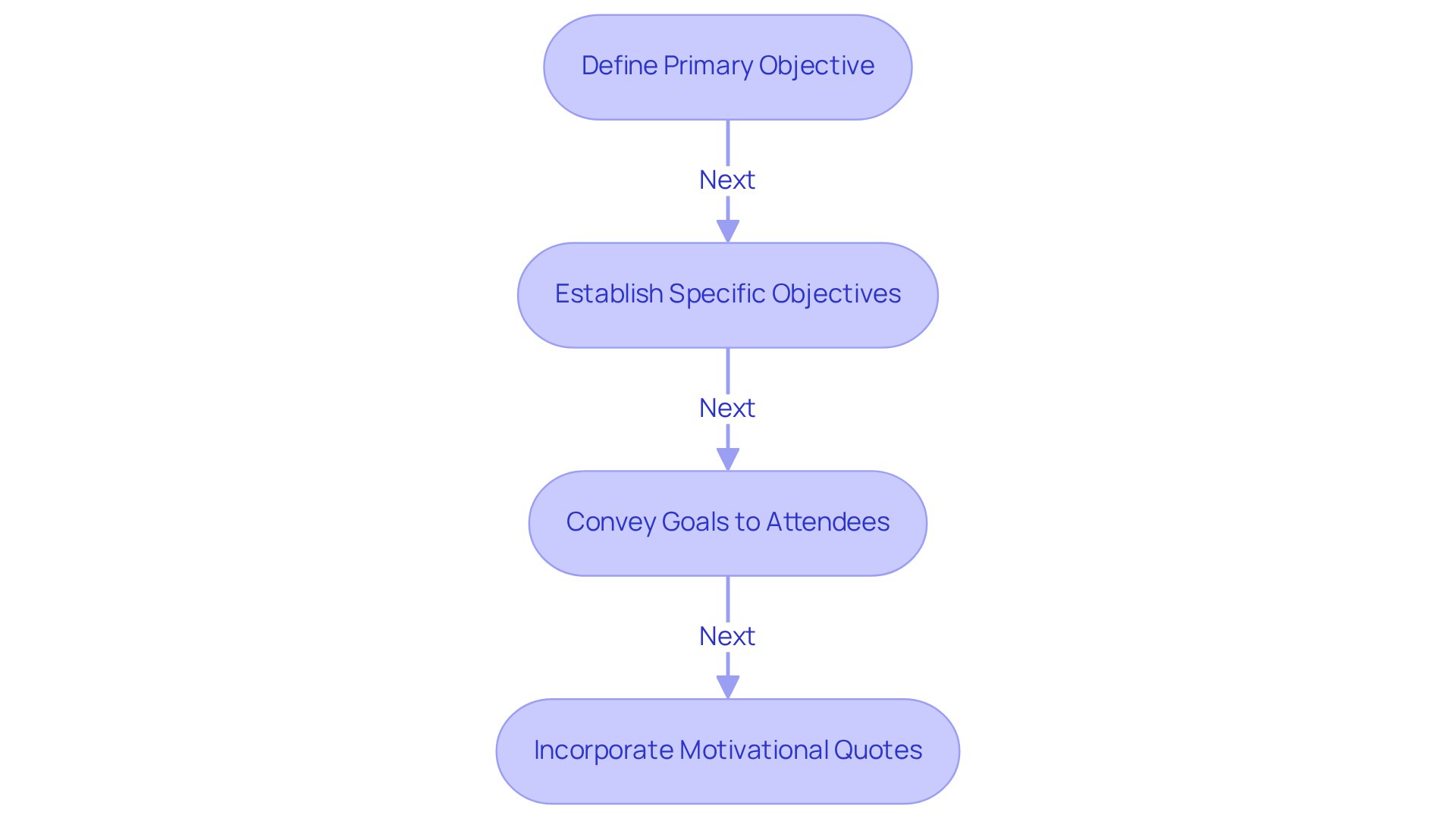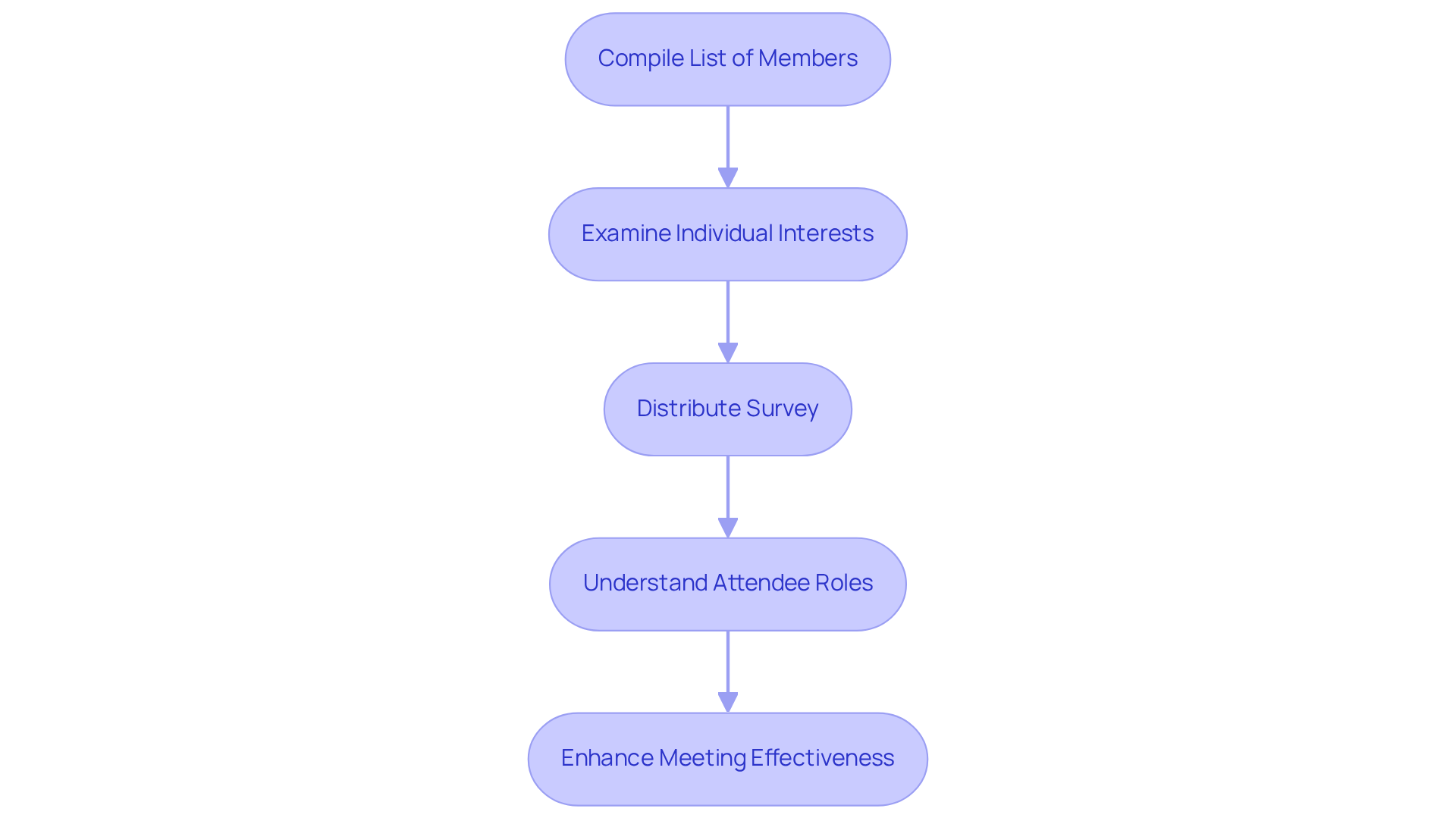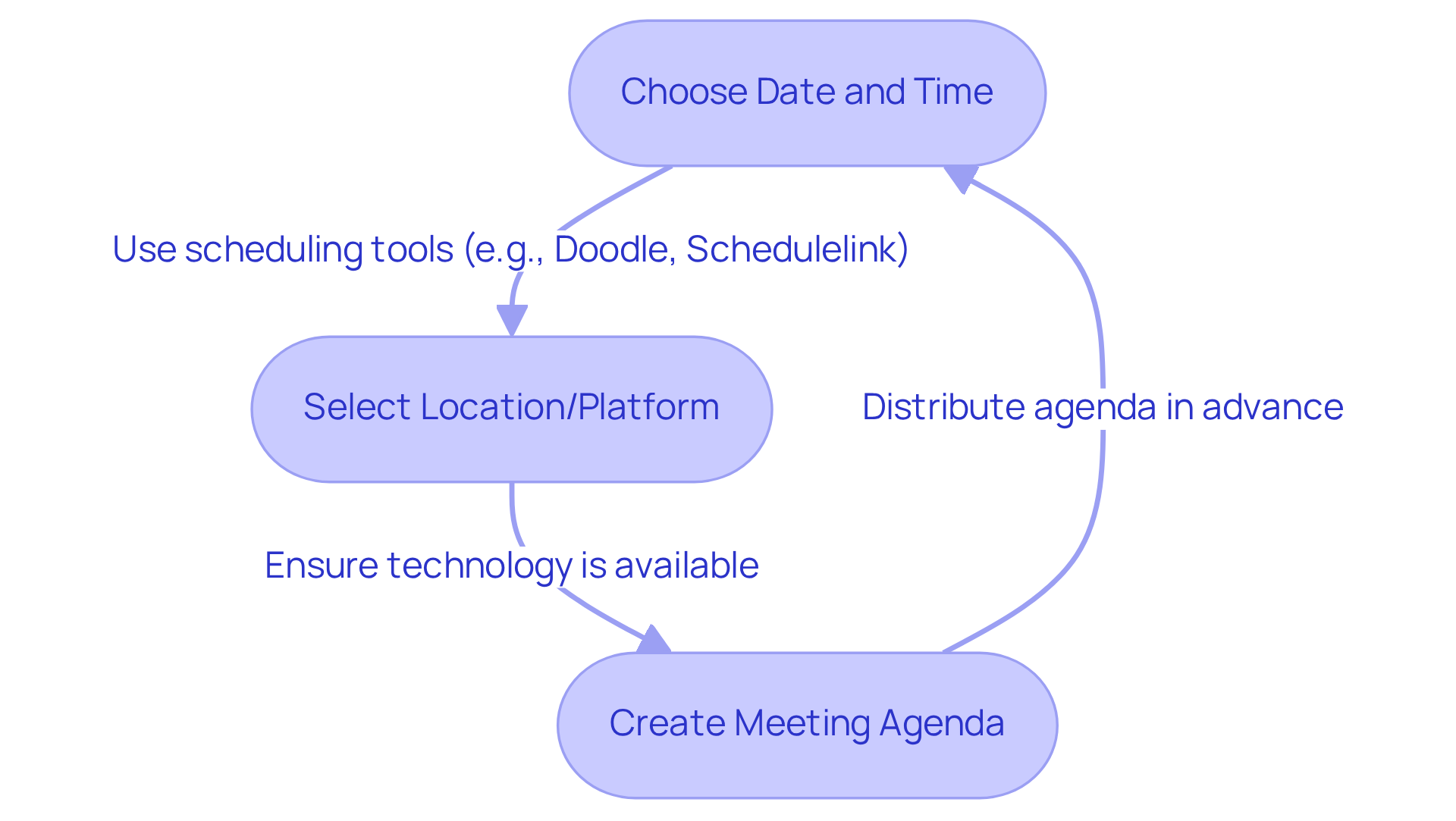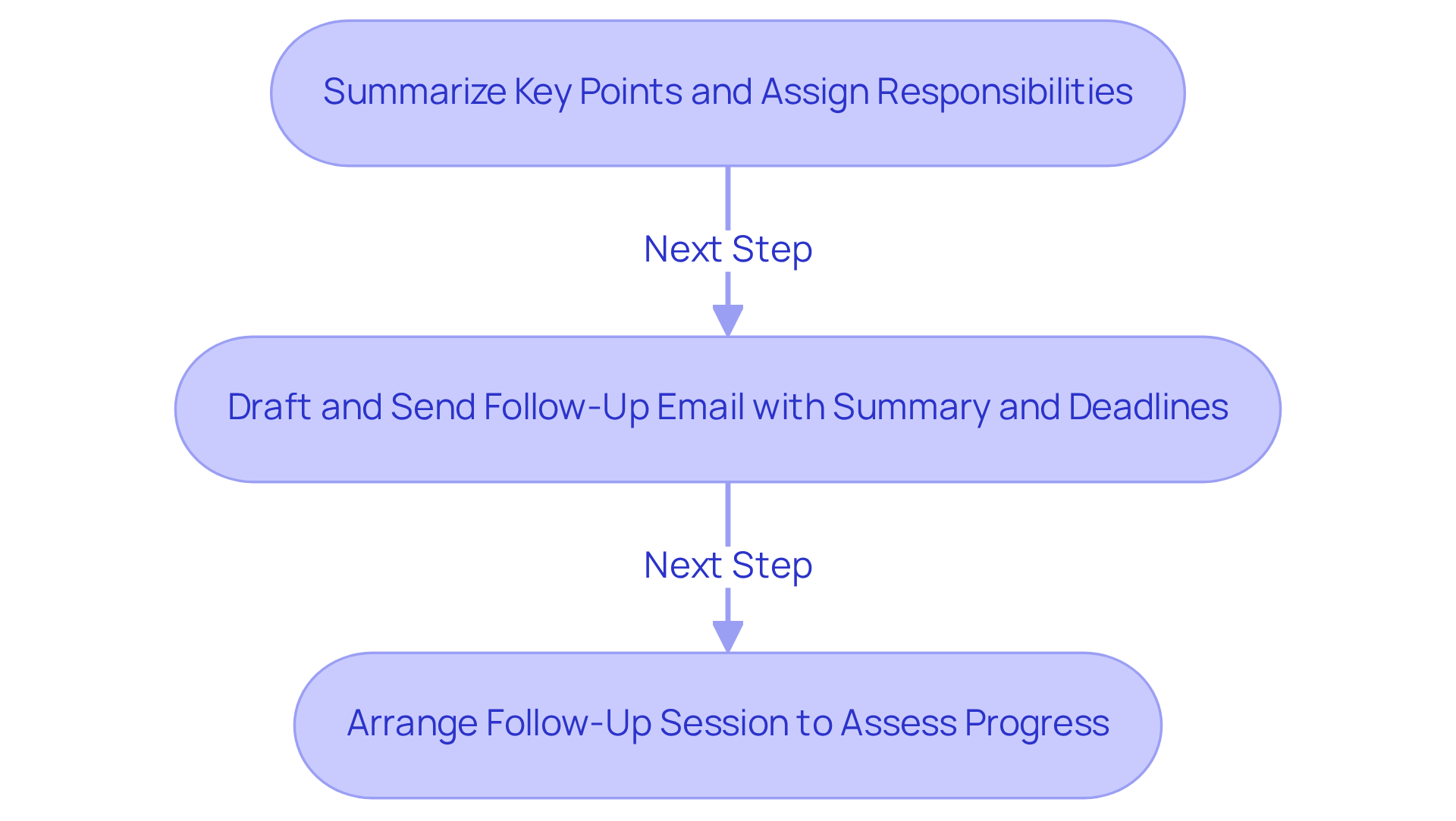4 Steps to Prepare for Your Initial Meeting Effectively

Overview
The article delineates four essential steps for effectively preparing for an initial meeting:
- Identifying objectives
- Researching participants
- Planning logistics
- Establishing follow-up procedures
These steps are crucial in addressing the prevalent issue of communication inefficiencies that can hinder operational success. By emphasizing the importance of clear goals, the article highlights how understanding attendee interests can significantly enhance engagement and productivity.
Furthermore, the research into participants allows for tailored discussions that resonate with attendees, fostering a more productive dialogue. Planning logistics ensures that the meeting runs smoothly, while establishing follow-up procedures reinforces accountability, ensuring that actions discussed are executed post-meeting. Each of these steps is supported by practical advice and statistics, underscoring their impact on meeting outcomes.
Ultimately, this comprehensive approach not only enhances meeting productivity but also cultivates a culture of accountability and engagement within organizations. By implementing these strategies, professionals can transform their initial meetings into effective platforms for collaboration and decision-making.
Introduction
Effective meetings stand as the cornerstone of successful collaboration; however, many professionals find themselves ensnared in unproductive discussions. Preparing for an initial meeting transcends mere formality; it represents a pivotal opportunity to establish the groundwork for meaningful dialogue and actionable outcomes.
How can we ensure that these gatherings evolve from mundane to impactful? By adhering to a structured approach to preparation, individuals can clarify objectives, engage participants, and cultivate an environment where every voice is heard and valued.
Identify Meeting Objectives and Goals
-
Begin by clearly defining the primary objective of the initial meeting. In the initial meeting, consider what you aim to achieve—whether it’s making a decision, brainstorming ideas, or sharing updates. This clarity sets the tone for a productive discussion in the initial meeting.
-
Establish specific, measurable objectives for the gathering. For instance, rather than stating ‘discuss project updates,’ articulate a goal like ‘review the progress of Project X and identify any roadblocks.’ This specificity not only guides the conversation but also enhances accountability. Studies indicate that merely 30% of gatherings are regarded as effective, underscoring the importance of establishing clear goals.
-
Convey these goals to all attendees at the initial meeting beforehand. Sending a pre-meeting email that outlines the goals and expected outcomes ensures that everyone arrives prepared to contribute effectively. Research shows that 72% of professionals think clear objectives are crucial for productive gatherings, and 67% assert that having a clear agenda is the most significant factor when conducting effective sessions.
-
Incorporate motivational quotes to inspire focus and commitment. For example, as John Doerr states, ‘We must realize—and act on the realization—that if we try to focus on everything, we focus on nothing.’ Additionally, Vince Lombardi reminds us that ‘Success demands singleness of purpose.’ This perspective can assist attendees in prioritizing their contributions and aligning with the objectives of the gathering.

Research Participants and Their Interests
-
Compile a comprehensive list of all members along with their roles within the organization. This foundational step in the initial meeting is essential for grasping their perspectives and aligning them with the session’s objectives.
-
Examine each individual’s interests and past contributions to similar discussions. Utilize resources such as LinkedIn profiles, previous discussion notes, or direct conversations to gather this information, ensuring a well-rounded understanding of their viewpoints.
-
Distribute a brief survey or questionnaire to gather insights on the subjects individuals are most eager to discuss. This proactive strategy enables you to tailor the schedule, improving significance and involvement during the discussion.
Comprehending attendee roles is essential; statistics indicate that 71% of gatherings are considered unproductive, frequently due to insufficient engagement. By customizing agendas to attendee interests in the initial meeting, organizations can significantly enhance session effectiveness and promote a more collaborative environment. As David Smith observes, “Without clear objectives or defined discussion points, gatherings risk becoming unproductive.” Moreover, with just 30% of gatherings viewed as effective, it is essential to involve attendees early, since 52% of individuals lose interest after merely 30 minutes.

Plan Meeting Logistics and Agenda
-
To effectively organize a gathering, it is crucial to choose the optimal date and time, taking into account the availability of all participants. Utilizing scheduling tools such as Doodle or Schedulelink can streamline this process, ensuring a consensus is reached efficiently. With 43% of employees spending over three hours weekly on scheduling, and 71% of professionals losing valuable time due to unnecessary or canceled appointments, these tools are essential for significantly reducing wasted time.
-
Selecting an appropriate location or online platform that comfortably accommodates all attendees is equally important. Ensure that the necessary technology, including projectors and video conferencing tools, is available and functioning properly. The right environment can enhance attendee satisfaction; in fact, 71% of professionals believe that meeting venues influence engagement levels, and 35% prefer smaller groups for improved meeting quality.
-
A thorough plan outlining the topics to be discussed, the time allocated for each item, and the designated leader for each discussion is vital. Distributing this plan in advance allows participants to prepare effectively. Notably, gatherings with a clear agenda are linked to increased productivity, yet only 37% of these events currently utilize this essential tool.

Establish Follow-Up Procedures and Next Steps
-
At the conclusion of the gathering, it is imperative to summarize the key points discussed and the decisions made. Clearly outlining the next steps and assigning responsibilities to specific individuals fosters accountability, ensuring that everyone understands their roles moving forward.
-
A follow-up email should be drafted, containing a summary of the discussion, the action items, and deadlines for each task. This email ought to be dispatched to all attendees shortly after the session concludes. Notably, research indicates that not following up on an opening email results in a 9% average reply rate, while adding at least one follow-up increases this to around 13%, significantly boosting engagement and accountability.
-
It is essential to arrange a follow-up session or check-in to assess progress on the action items. This practice helps maintain accountability and ensures that the objectives established during the initial meeting are being met. As Beatrice Visser notes, “Only 12% of salespeople demonstrate persistence by making three or more follow-ups,” highlighting the importance of consistent follow-up practices in achieving better outcomes.

Conclusion
Preparing for an initial meeting is not just beneficial; it is essential for ensuring success and productivity. Establishing clear objectives, understanding participant interests, planning logistics, and implementing effective follow-up procedures significantly enhance the quality of discussions and outcomes. This structured approach fosters engagement and aligns all attendees toward a common goal, ultimately leading to more effective meetings.
Key insights emphasize the critical importance of:
- Defining specific meeting goals
- Researching participants
- Crafting a well-thought-out agenda
Identifying objectives ahead of time, understanding the interests of attendees, and creating a conducive environment for discussion are vital steps that contribute to a fruitful meeting experience. Moreover, implementing follow-up procedures ensures accountability and progress, reinforcing the commitments made during the session.
In conclusion, the significance of thorough preparation for meetings cannot be overstated. By investing time in these strategies, organizations can transform their meetings from unproductive gatherings into dynamic sessions that drive results. Embracing these best practices enhances individual contributions and cultivates a culture of collaboration and accountability, ultimately leading to greater success in achieving organizational goals.
Frequently Asked Questions
What is the first step in preparing for an initial meeting?
The first step is to clearly define the primary objective of the meeting, considering what you aim to achieve, such as making a decision, brainstorming ideas, or sharing updates.
How should objectives for the meeting be established?
Objectives should be specific and measurable. For example, instead of saying ‘discuss project updates,’ a goal could be ‘review the progress of Project X and identify any roadblocks.’
Why is it important to convey meeting goals to attendees beforehand?
Conveying goals ensures that everyone arrives prepared to contribute effectively, which enhances the productivity of the meeting.
What percentage of professionals believe that clear objectives are crucial for productive gatherings?
Research shows that 72% of professionals think clear objectives are crucial for productive gatherings.
What is the significance of having a clear agenda for meetings?
Having a clear agenda is considered the most significant factor for conducting effective sessions, as noted by 67% of professionals.
How can motivational quotes be used in meetings?
Motivational quotes can inspire focus and commitment among attendees, helping them prioritize their contributions and align with the meeting’s objectives.
Can you provide examples of motivational quotes to use in meetings?
Yes, one example is John Doerr’s quote, ‘We must realize—and act on the realization—that if we try to focus on everything, we focus on nothing.’ Another is Vince Lombardi’s quote, ‘Success demands singleness of purpose.’
